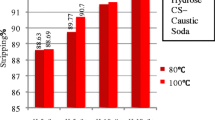Abstract
This research studies how reactive dyes affect properties of cellulosics. It was found that covalently bonded reactive dyes accelerate acidic hydrolysis of cellulose and such an accelerated hydrolysis causes a decrease in durability of reactive dyed cellulosics, especially, those with heavy shades. The problem is unsolved due to the lack of knowledge of the mechanism of fiber tendering. This research investigates the effect of structures of reactive dyes on the degree of tendering of cotton. It demonstrates that tendering of dyed cotton can be attributed to the electric field effect of the dye on cellulose. Our research also finds that the poor wet-crocking fastness of reactive dyed cotton fabrics results from reactive tendering. Based on the proposed mechanism of fiber tendering, we have designed reactive dyes with minimized field effect which was quantified using simplified Kirkwood–Westheimer model. Fabrics dyed with these new dyes demonstrate the reduction in fiber tendering and the improvement in wet-crocking fastness.
Graphical abstract







Similar content being viewed by others
References
Aspland J (1992) Part 2: practical application of sulfur dyes. Text Chem Color 24(4):27–31
Božič M, Kokol V (2008) Ecological alternatives to the reduction and oxidation processes in dyeing with vat and sulphur dyes. Dyes Pigm 76:299–309
Cui H (2004) Color fastness improvement (II). Dye Finish 22:004
Fan F, Zhang W, Wang C (2015) Covalent bonding and photochromic properties of double-shell polyurethane-chitosan microcapsules crosslinked onto cotton fabric. Cellulose 22:1427–1438
Gordon S, Hsieh Y (2006) Cotton: science and technology. Woodhead Publishing, Cambridge
Hao L, Wang R, Fang K, Liu J (2013) Ultrasonic effect on the desizing efficiency of α-amylase on starch-sized cotton fabrics. Carbohydr Polym 96:474–480
Hauser PJ, Tabba AH (2001) Improving the environmental and economic aspects of cotton dyeing using a cationised cotton. Color Technol 117:282–288
Kan C, Yuen C, Tsoi W (2011) Using atmospheric pressure plasma for enhancing the deposition of printing paste on cotton fabric for digital ink-jet printing. Cellulose 18:827–839
Luttringer J (1993) A new generation of reactive dyes for cotton. Text Chem Color 25(5):25–29
Maxwell J, Gordon S, Huson M (2003) Internal structure of mature and immature cotton fibers revealed by scanning probe microscopy. Text Res J 73:1005–1012
Minutes of shirt manufacturers meeting (1990)
Mu B, Xu H, Yang Y (2015) Accelerated hydrolysis of substituted cellulose for potential biofuel production: kinetic study and modeling. Biores Technol 196:332–338
Mu B, Xu H, Li W, Yang Y (2018) Fast hydrolysis of cellulose catalyzed by its substituents for potential biomass conversion. Bioresour Technol 273:305–312
Orttung WH (1978) Extension of the Kirkwood–Westheimer model of substituent effects to general shapes, charges, and polarizabilities. Application to the substituted bicyclo [2.2.2] octanes. J Am Chem Soc 100:4369–4375
Patiño A, Canal C, Rodríguez C, Caballero G, Navarro A, Canal JM (2011) Surface and bulk cotton fibre modifications: plasma and cationization. Influence on dyeing with reactive dye. Cellulose 18:1073–1083
Phillip L (1990) International fabricare institute specical reporter: shirt washing process part II, No 5
Rafique S, Khattak SP, Hussain T, Ahmad B, Seemi M (2015) Colour fastness properties of polyester/cotton fabrics treated with pigment orange and various functional finishes. Asian J Chem 27(12):4568–4574
Rizk H, Ibrahim S, El-Borai M (2015) Synthesis, fastness properties, color assessment and antimicrobial activity of some azo reactive dyes having pyrazole moiety. Dyes Pigm 112:86–92
Wang C, Wang L, Huang Y, Nan X, Fan Q, Shao J (2017) Preparation and characterization of Phthalocyanine Blue encapsulated with silane coupling agent for blue light curable inkjet printing of textiles. Dyes Pigm 139:453–459
Wang L, Li R, Wang C, Hao B, Shao J (2018) Surface grafting modification of titanium dioxide by silane coupler KH570 and its influences on the application of blue light curing ink. Dyes Pigm 163:232–237
Yang H (2003) Color fastness to wet crocking of cotton fabric in deep shade. Dye Finish 11:004
Yang Y, Hughes JE (1997) Reactive tendering: the electron-withdrawing inductive effect of reactive dyes on acid hydrolysis of β-1,4-glucosidic bonds. Text Chem Colorist 29:23–29
Yang D-F, Kong X-J, Gao D, Cui H-S, Huang T-T, Lin J-X (2017) Dyeing of cotton fabric with reactive disperse dye contain acyl fluoride group in supercritical carbon dioxide. Dyes Pigm 139:566–574
Yu J, Shao D, Sun C, Xu C, Hinks D (2017) Pilot-plant investigation on low-temperature bleaching of cotton fabric with TBCC-activated peroxide system. Cellulose 24:2647–2655
Zhang X, Fang K, Zhang J, Shu D, Gong J, Liu X (2017) A vacuum-dehydration aided pad-steam process for improving reactive dyeing of cotton fabric. J Clean Prod 168:1193–1200
Acknowledgments
This research was financially supported by National Institute of Food and Agriculture [Multi-State Project S1054 (NEB 37-037)], USDA Hatch Act, and the Agricultural Research Division at the University of Nebraska-Lincoln. Authors are grateful to China Scholarship Council for its financial support to Wei Li, and the John and Louise Skala Fellowship and American Association of Textile Chemists and Colorists Students Grant for their financial support to Bingnan Mu.
Author information
Authors and Affiliations
Corresponding author
Additional information
Publisher's Note
Springer Nature remains neutral with regard to jurisdictional claims in published maps and institutional affiliations.
Rights and permissions
About this article
Cite this article
Mu, B., Li, W. & Yang, Y. Reactive tendering: mechanism and solutions. Cellulose 26, 5769–5781 (2019). https://doi.org/10.1007/s10570-019-02459-0
Received:
Accepted:
Published:
Issue Date:
DOI: https://doi.org/10.1007/s10570-019-02459-0




